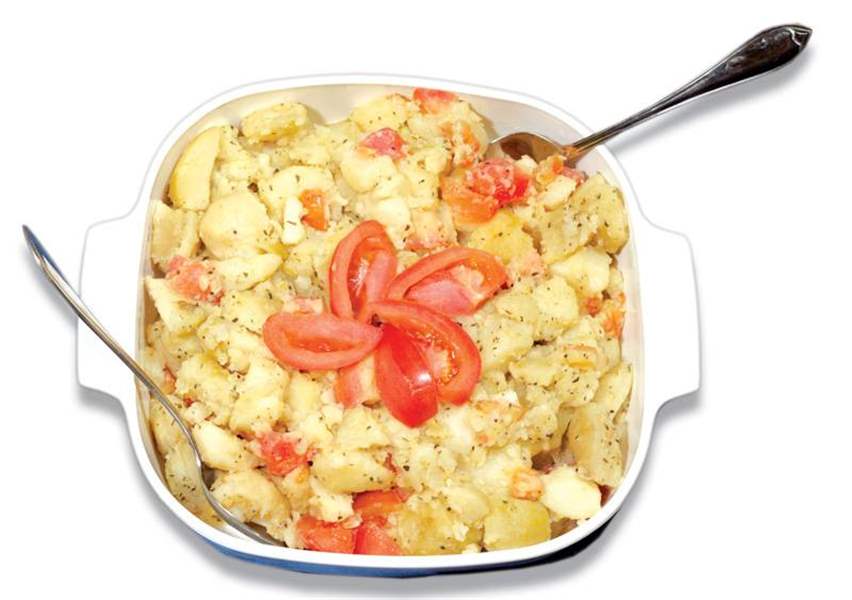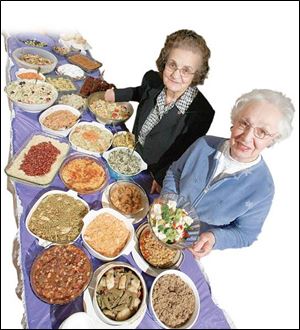
Food is meat-free and dairy-free at Orthodox churches
3/6/2007

Mary Markham and Ann Mulopulos with some of their potluck dishes.
During the Lenten season, members of Orthodox Christian churches gather for potluck dinners after the presanctified liturgy on Wednesday nights.
All the food is meat-free and most is dairy-free, in accordance with the fasting guidelines observed during Great Lent, which started Feb. 19 for the Orthodox Church.
At the Pan-Orthodox dinner following presanctified liturgy, church members bring dishes custom to their ethnic background, says Julie Olmstead who attended the Lenten season s first Pan-Orthodox potluck dinner at Holy Trinity Greek Orthodox Cathedral on Wednesday evening.
Among those at the service were members of St. Elias Antiochian Orthodox Church, Holy Trinity Greek Orthodox Cathedral, St. George Orthodox Cathedral in Rossford, and St. George Antiochian Orthodox Cathedral in Toledo.
It s not uncommon to see Lebanese-Syrian dishes such as hummus, lentils and rice, and vegetarian grape leaves; Bulgarian foods such as Margaret Ostas Potato Manja (potato in tomato sauce), and Greek dishes such as Mediterranean Salad , Spinach with Rice, and Peas and Artichokes. Mrs. Ostas is a member of St. George Orthodox Cathedral in Rossford. There also is Midwest cooking with salads and vegetable dishes such as a corn medley, pasta dishes, and a 4 Bean Salad made by Mrs. Olmstead, who is also a member of St. George in Rossford.

Wednesday evening was no different. The table was filled with vegetarian dishes worthy of inspiring any cook. People think they can t cook with all vegetables, but it s amazing to see the variety of combinations, agree Holy Trinity members Ann Mulopulos and Olympia Ntakos.
Mrs. Mulopulos prepared Cauliflower Casserole , 3 Bean Vegetable Chili, and Carrot Cake. (Desserts are made without dairy products, too.)
Mrs. Ntakos prepared a big dish of Mediterranean Salad minus the crumbled feta cheese (which is not used during Lent because it is dairy). The recipe has many variations, depending on the ingredients at hand. In summer, for example, seasonal fresh vegetables such as green pepper, cucumber, and eggplant may be added, she says.
Holy Trinity member Mary Markham made Peas and Artichokes. She likes to use canned peas, but frozen peas may be used. Greek Potato Salad made by Demetra Theodorou was a simple combination of cooked potatoes, tomato, onion, salt, pepper, olive oil, and oregano.

Many of the hot dishes are casseroles such as an okra and potato dish flavored with tomatoes. But whether they are baked in the oven or cooked on the stove top, many start with sauteing onions in olive oil.
Lenten fasting
The tradition of fasting in the early Christian church includes abstaining from meat, poultry, fish (with a backbone), cheese, eggs, milk, and other dairy products.
Shellfish such as shrimp or squid and octopus are allowed, Mrs. Ntakos says.
Thus there were at least two casseroles with Shrimp and Rice at the dinner. One was made by Ann Hadgigeorge, wife of the Rev. Chris Hadgigeorge, pastor emeritus of Holy Trinity.

During the Lenten season, cooks are always looking for new recipes using vegetables.
But the development of the fast and the importance of the Lenten meal with meat-free and dairy-free foods with other Christians has great spiritual significance, says the Rev. Paul Albert of St. Elias Antiochian Orthodox Church on Harroun Road in Sylvania.
It is an austere and penitential time, he says. The positive is the types of foods are a closer diet to those in Paradise in Genesis. Our foods [for fasting] are simpler and healthy and filling. We eat a little less. Fasting is linked to prayer and giving to the poor.
Preparation for fasting began this year with Meatfare Sunday on Feb. 11. It was the last Sunday we are eating meat until Pascha (Easter), Father Paul says. It is the equivalent of the Carnival Sunday in the West. Beginning with [Feb.] 12th, we enter in the first phase of Lent, which is the meatfast, but when we are still eating dairy foods.
On Feb. 18, Cheesefare Sunday, the day preceding Great Lent, was observed. It was the last day of eating dairy foods until Pascha, Father Paul says. Forgiveness Sunday began with evening vespers. We are called by Christ to forgive one another and to ask forgiveness of one another. We bow before one another and give a holy kiss by kissing on each cheek and asking forgiveness.
On Wednesdays during Great Lent, presanctified liturgy services are held.
Potluck tradition
In the first week of Great Lent, each of the four area churches holds its own potluck dinner following the liturgy. In subsequent weeks, members of the churches join together to share a meal after the service.
With a common understanding of fasting [that] is the reason why you can come from any culture, Father Paul says. It s the same discipline and practice of the faith, even though they come from different backgrounds. Everybody can come to the table with their unique ethnic traditions and still uphold the fasting discipline of the church.
On Wednesday, the churches members joined to observe the liturgy followed by a potluck dinner. On March 14, they will gather at St. George Orthodox Cathedral in Rossford; on March 21, they will meet at St. Elias Church in Sylvania. For the final Wednesdays, they will return to their respective churches for potlucks.
The result is an interesting array of meatless, dairy-free vegetarian dishes. The recipes may be used by anyone interested in vegetarian recipes.
The foods are filling, delicious, healthful, and quite economical.
Contact Kathie Smith at: food@theblade.com or 419-724-6155.